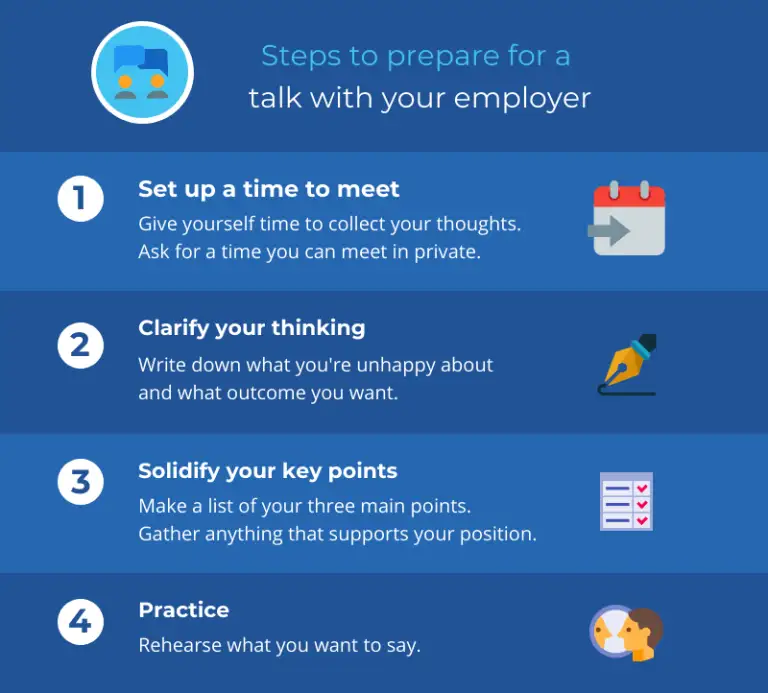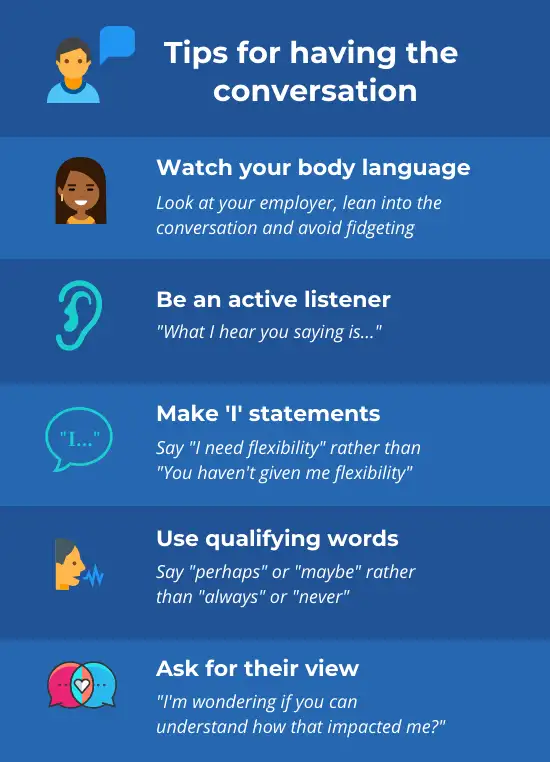
Many issues at work are best sorted out with an honest and respectful conversation. Whether it’s bringing up concerns about something or making a request, talking with your employer is quicker and less daunting than taking more formal steps. Still, the thought of approaching your boss can be stressful. We offer tips to help you talk with your employer.
What you should know
Sometimes informal steps don’t fit the situation. You might prefer writing a letter or making a formal complaint, rather than talking with your employer. That’s up to you. You can start with whatever step best fits your situation.
It can be helpful to first talk the issue out with friends, colleagues or your union representative (if you’re in a union). They might be able to tell you how a similar issue was handled. You may want their support if you later decide to take a more formal step, such as writing a letter or making a complaint.
You could also call in support for the actual meeting with your employer. You might ask a co-worker or (if you’re in a union) your union representative to join you. Their presence can provide moral backing. And they can be the note-taker, freeing you up to be fully in the conversation. If you decide to bring someone along, make sure you get your employer’s permission in advance.
Document the steps you take
If you contact others for help, keep a written record of whom you spoke with, what was said, and any action taken. If you contact someone outside your workplace, take care not to share any of your employer’s confidential information.
Raising a workplace issue, making a request, or bringing a complaint doesn’t give an employer grounds to fire you for just cause. But unfortunately, some bosses are short-tempered and don’t react well to being confronted.
There are several laws that protect you if your boss fires you for raising a complaint. If you get fired for bringing a discrimination complaint, you may have a human rights claim. If you get fired for a workplace safety or harassment complaint, you can make a “prohibited action complaint” to WorkSafeBC. Being fired for bringing a complaint might also justify extra damages if you sue in court.
However, be aware that unless certain factors are in play (such as human rights issues), your employer can end your employment at any time as long as they give you enough advance notice or severance pay. (What’s enough notice depends on what’s written in your employment contract — or the minimum you’re entitled to by law.)
Steps to having the conversation
Avoid going to your employer when you’re still emotionally raw. Give yourself a cooling-off period to collect your thoughts and composure. Ask your employer for a time you can meet in private.
Before you meet with your employer, prepare what you want to say.
Write down what you’re unhappy about and what you want to achieve. If there was a specific incident, make note of the date and place it happened and how it made you feel. Describe any conversations you’ve had about it with anyone since then (don’t mention conversations with your lawyer or doctor).
List the three main points you want to make. This can help you figure out what’s most important to you, and help you remember what you want to say.
Before you speak to your employer, think hard about the outcome you want. How do you hope your employer responds? One way to think about this is to put yourself in their shoes. Ask yourself: What would I do if I were them? If you can make reasonable, concrete suggestions, you’ll give your employer something to work with. You’re more likely to get at least part of the solution you’re after.
Gather together anything that supports your position — any emails or letters that relate to the issue, your paystubs (if part of your pay was missing, for example), your written employment contract (if you have one). If there are any specific laws that apply to your situation, make sure you understand them and consider if you want to raise them with your employer.
In private, rehearse what you want to say to your employer.
| Step | Details |
|---|---|
| 1. Set up a time to meet | Give yourself time to collect your thoughts. Ask for a time you can meet in private. |
| 2. Clarify your thinking | Write down what you're unhappy about and what outcome you want. |
| 3. Solidify your key points | Make a list of your three main points. Gather anything that supports your position. |
| 4. Practice | Rehearse what you want to say. |
Here’s a template you might follow for the conversation:
1. Respectfully and calmly explain what the problem is
"I’m concerned about the new work schedule."
2. Explain briefly the impact on you
"With so many early morning shifts, it’s challenging for me to get my kids to school."
3. Stick to the facts
"The school’s before- and after-school program is full and has a year-long waitlist."
4. Suggest one or more solutions
"Perhaps I could have the occasional morning shift, and more afternoon shifts."
5. Ask for a response by a certain date
"Can you please let me know how you will be addressing this issue by [date]."

After the conversation with your employer, make notes of what you both said and the date and time you spoke. Be sure to make a note of the outcome. Did your employer say they’d get back to you by a certain date with a decision, for example?
After the conversation with your employer, it may be useful to provide the employer with a summary of the conversation by email. List the main points covered and the requested response deadline. If the issue doesn’t get resolved, this brief record of the discussion may be helpful down the road.
Who can help

Employment Standards Branch
The BC government office that deals with complaints against employers.

WorkSafeBC
Deals with complaints about unsafe working conditions and injuries on the job.

Employment and Social Development Canada
Deals with complaints against employers in federally-regulated industries.

BC Human Rights Tribunal
Deals with discrimination complaints under BC law.



